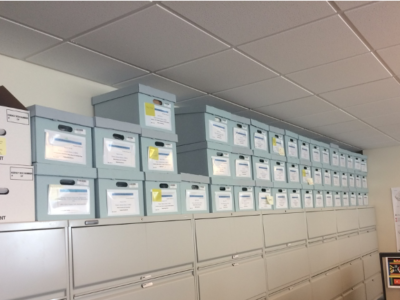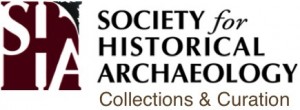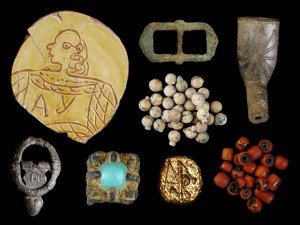
Collections-Based vs. Field-Based Research: A Need for Dialogue
By Julia A. King
Collections-based research is a form of archaeological excavation in its own right. Searching through the contents of boxes and old catalogs found deep in repositories is a process full of discoveries, as a group of us working in the Potomac River valley has learned over the last three years. Our purpose has been a reconsideration of colonialism as it was experienced in the lower Potomac and how that experience compares with places elsewhere, both within and beyond the Chesapeake. Through the reexamination of 35 archaeological collections recovered from sites ranging in date from 1500 through 1720, we have been able to develop narratives of interaction and encounter that are revealing just how much there is to learn from existing collections.
We could take such a regional focus only because we turned to existing collections; no single site or settlement could reveal this complex story. The collections we used were generated over a period of decades, beginning in the 1930s and 40s and continuing right on through to the present, each with its own history of creation. Some of the collections were generated by academic institutions, some by museums, some by volunteer organizations, and some by cultural resource management firms. At least one was generated by professionals generously volunteering to “rescue” a site that was slated for imminent destruction through a change in land use. As varied as these collections are, the comparative perspective our project required revealed relationships among these sites that otherwise would have gone unnoticed.
As the project winds down, there are observations that may be of use to people both using collections and generating them in the field.
The first observation is that almost any collection is a good collection. For example (and not surprisingly), the collections we used that had been generated in the 1930s and 40s were problematic, but use them we did. These materials almost always lacked provenience information other than to the site, and, worse, artifacts we might have found useful had long ago been discarded, lost, or misplaced. Still, we included these collections anyway because, as problematic as they are, they are the only available datasets for some of the lower Potomac’s most important settlements. Our research results were better and stronger as a result even if the use of these collections was limited.
Recently generated collections (the 1980s on) also have their challenges. These collections have been created using a variety of methods. Some of the collections, for example, were the result of wide-area survey projects while others were generated through site-focused data recovery efforts. We anticipated that these different methods would require a careful consideration of how collections were compared and we proceeded accordingly. We had to carefully consider sample size (including not just the nature of the test units but screen size) and artifact density, variability, and richness before we could begin organizing assemblages for comparison. In some cases, rather than comparing artifact assemblages, we compared the narratives developed for each site. Not perfect, but not that bad either. And, the different recovery methods did have a bright side: wide-scale surveys provided a broader landscape perspective lacking in focused site excavations, and the different sets of data could be complementary.
The variability we observed in data collection strategies, however, does point to a need for dialogue about the ongoing generation of collections today. As more and more sites are excavated and their collections curated and made accessible, researchers are moving from considering a single site to considering a far broader context, as we are doing for the lower Potomac. Field practices and decisions that may work within the context of a single site (or landscape) may not support the kind of comparative research made possible by the increasing availability of other collections.
Perhaps the most troubling issue we observed is a disciplinary mindset (for want of a better phrase) which continues to foster the never-ending field season, resulting in un-cataloged or under-cataloged collections along with no site report. More materials – many more – are dug up than can be reasonably processed and reported, despite universal acknowledgment that the curation crisis remains in full swing. Some of these materials make it into repositories, others don’t. Not surprisingly, most of these materials come from sites with lots of artifacts, increasing the dataset for these types of sites while low density sites remain under-represented in the collections archive.
Also problematic is the variation evident in data collection strategies, not just from site to site but within sites. Excluding shovel tests, unit sizes varied widely in size (from 1.5-by-1.5-feet to 2-by-2-meters) and shape (from squares to rectangles), sometimes within sites. This can dramatically complicate spatial analysis. In a few cases, new grid systems were imposed at previously-tested sites, making the tracking of proveniences especially difficult. In one case, screen size was switched mid-project, presumably to enhance artifact recovery but making intrasite comparison as challenging as intersite comparison.
The condition of field records was also disturbing: while many were detailed in the kinds of information they contained, not a few were woefully limited or incomplete (or altogether missing), with critical information left unrecorded. In one particularly egregious example, linking strata to excavated deposits at one very important site may ultimately prove to be impossible because elevation data were simply not recorded.
No doubt most archaeologists can relate to the events that might lead to these problems. I struggle to get site reports completed in an environment where peer-reviewed publications and teaching evaluations are rewarded but site reports barely acknowledged. Sometimes new grid systems are necessary when benchmarks from earlier projects can’t be relocated. And, believe me, I know my volunteers and my students would rather dig and find stuff than wash. Finally, a lack of resources should never preclude efforts to “rescue” truly threatened sites.
Collections-based research – using existing collections to pose and answer scholarly questions – and field-based research – actively generating new collections to pose and answer questions – represent two approaches in the effort to create archaeological knowledge. Proponents of collections-based work decry the making of new collections as a perpetuation of the curation crisis. Their point is well-taken, but are they being heard? Is it realistic to think all digging must or should or will stop? Meanwhile, newly-generated assemblages become the collections of tomorrow. The cycle continues.
The collections-based Potomac River project does not offer a perfect solution, but it does suggest one way forward. Those who generate collections in the field should work with those who use and advocate collections-based research to forge a critical dialogue about methods, methodology, and the ethics of fieldwork. Sure, the ethical concerns of generating and using collections may not rival recent discussions concerning treasure salvors or reality stars on backhoes, but don’t let that banality obscure the issues at stake. Collections are integral to both field- and collections-based research. By looking not just at the scholarly findings of collections-based research but the methods that resulted in the creation of those collections, we can resolve to dig smarter. Dig less, catalog more. Create collections that will be usable and that will be comparable, now and in the future.
Acknowledgments
“Colonial Encounters: The Lower Potomac Valley at Contact, 1500-1720” was funded by a grant from the National Endowment for the Humanities with additional support from the Maryland Archaeological Conservation Laboratory, the Colonial Dames of America Chapter I, and Mr. Philip J. Mudd. Project participants include Gregory J. Brown, Laura J. Galke, Brad Hatch, Barbara J. Heath, Audrey J. Horning, Silas Hurry, Phil Levy, Mary Kate Mansius, Lauren McMillan, David Muraca, Dennis J. Pogue, Patricia Samford, Esther L. Rimer, and Scott M. Strickland. All of the datasets from this project along with interpretive papers will become available in early 2015 via the internet. The opinions in this blog post are my own.
The above is the inaugural blog post of a new series sponsored by the SHA Collections and Curation Committee. We will be inviting members who work with difference aspects of collections to blog about issues pertinent to collections management and use, as well as comment from their own perspective on the care and treatment of artifacts after they are removed from the ground. This follows on from the series of articles published in 2012-2014 in the SHA newsletter on similar themes. If you are sponsoring or participating in current projects incorporating collections-based components, we would welcome your suggestions and recommendations for blog posts. Please contact Sarah Platt at seplatt@syr.edu.






Thank you so much Julie, these issues are real close to my heart currently and the Colonial Encounters project is exactly the kind of effort that is needed now more than ever!